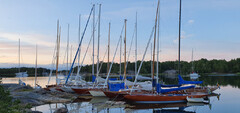WARY OF WARDROBE MALFUNCTIONS
Money and resource do not always win the day. Victory in the 2011-12 Volvo Ocean Race will also rely on those with the experience and vision to make the correct choices in the heat of the moment.
This time, the decisions on a team's sail wardrobe will be even more critical and rely on a strategy developed many months beforehand.
The new limitations and large reduction in the number of sails, outlined in the Volvo Open 70 Rule for the next event, intended to cap campaign costs without undermining the standard of racing and the performance of the boats.
This time teams can only build 15 pre-race sails per boat, (a modest reduction from 17 in the last race), and build a further 15 for the entire race, a much bigger cut from the 24 sails that were previously allowed.
Clearly, such a reduction will mean that broader crossovers are required between various sails in order to span a greater range of conditions, while longevity will also become a more significant factor.
But how easy will this be to achieve on highly refined machines that have, on both previous occasions, demonstrated record-breaking pace? Asking a Formula One
design team to run a 1,000bhp race car and deliver the same results on nearly 40 per cent fewer tyres would surely be a big ask.
"Planning how to use the team's budget will be more critical this time around," explained North Sails' Simon Fry. "In particular it will be the research that goes into the limited sails that will be most important. Measure twice, make once, as we like to say.
"With tight restrictions on the number of sails that can be built and carried aboard, a boat's sail inventory will have a big influence on the angles it can sail.
"So, while life may become simpler in the number of sails that are built and shipped around the world, the development that is behind them will mean that teams will have to have done their homework."
Perhaps the teams themselves will see a less expensive sail wardrobe as being a big advantage when on the fundraising trail.
In the last event, Green Dragon was one of several teams which raced around the world on a limited budget, where skipper Ian Walker had to balance performance requirements against what was affordable.
How does he see the new rules changing the race? "There will be some very big sail choice calls to be made both in the development of a sail wardrobe and in choosing what sails to take on a leg," he said.
"The first leg is a good example. You need a big range of sails for what was a 23-day leg last time and yet this time we're only allowed three spinnakers instead of five.
"We're going to need a code zero to get through the Doldrums and a masthead running sail for the trade winds and then a fast reaching sail or an A3 reacher.
"It's a similar story when considering upwind sails. Again, we're only allowed three headsails instead of the five we could carry last time. I guess this means that we will have to take a heavy jib, a number one genoa and a number three, blade style jib."
But it is not just sail choice that will be in the minds of the teams, nursing the sails around the world will be a big issue, too. "The bottom line is that the number one headsails will have twice as many hours on them as last time," Walker added.
"One of the really serious factors for mainsails last time was UV degradation. Our mainsail fell apart on the way to China. With only two mainsails allowed for the entire trip, including the in-port racing, the development of these sails will be very important and we're going to have to be even more careful with them."
Keeping the sails in one piece for longer will also require a different approach for some of the teams when it comes to sail handling and manoeuvres. "Every time we furled a sail we turned downwind to reduce the chances of damaging the sail. On a limited budget and wardrobe we just couldn't afford the risk. By the end we had used 19 sails for the whole race."
Although all the teams were aware of the need to preserve their precious sails, the current changes to the rule will mean that lessons learned out of necessity by the less well-off teams will place them in good stead for the next race.
But Walker believes that the rule changes could have further effects. "Ironically, I think stacking will be harder as the sails will be heavier," he said.
"To give an idea of the effect that stacking has, if we put all the gear on one side of the boat, we needed to swing the keel 25 degrees to the other side to level the boat. That's how much stacking counts."
But, when it comes back to the effectiveness of the sails once they are flying, Fry believes there may be some surprises in store. "We may find that some teams develop specialist sails even at the risk of knowing that for a particular leg they have a hole in their inventory," said Fry.
"But the fact is that a specialist sail will always beat a compromise sail and teams choosing this option would have to make sure they avoided certain sailing angles."
All of which could make for some very different tactical approaches to some of the most familiar legs of the world course.


























